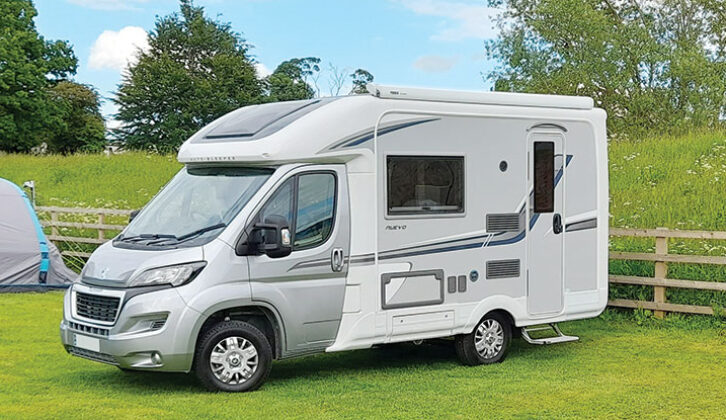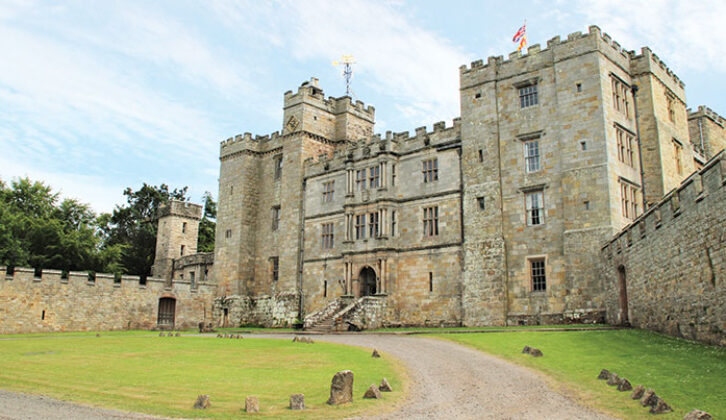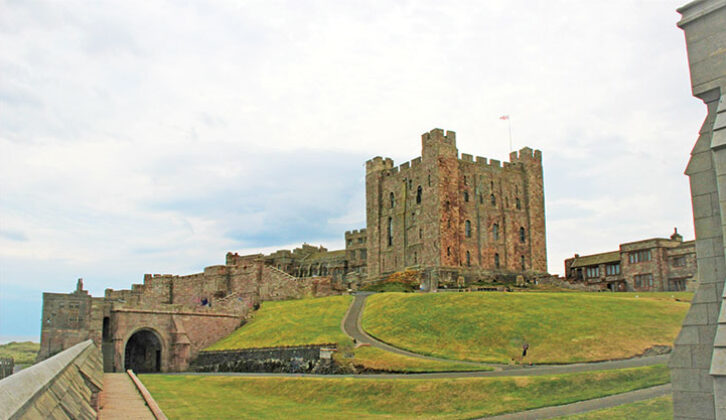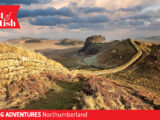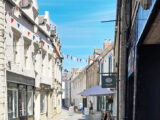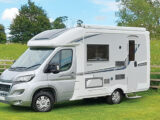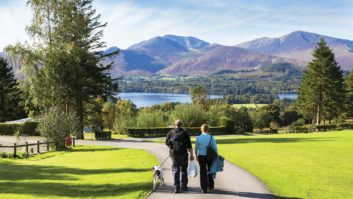A short break in Northumberland seemed an excellent way to make good use of a week’s holiday in mid-summer.
We know that the best motorhome site in any region would be one that allows you to take in as much of the area’s beauty as possible. With that in mind, we chose one site in the south of the county and another further north, so we could visit parts of this beautiful region that we had not previously seen.
Our first stop was Well House, a Caravan and Motorhome Club CL at Colwell, near Hexham. Although this site is tucked away, it makes a great base for exploring the area, and provides amazing views over the countryside. Late afternoons were spent watching the swifts swooping and flying over the fields in front of us.
We drove to Hexham on the Saturday morning. This fine old market town dates all the way back to Anglo-Saxon times and is rich in history.
First, though, the practicalities of parking (see our motorhome driving tips guide for advice on reversing your ‘van). Fortunately, we found a space in the Wentworth Car Park, with no height restrictions and spaces large enough for motorhomes.
Historic Hexham
We began by venturing up Hallstile Bank, a steep but mercifully short walk leading directly into the Market Place. There was a busy Farmers’ Market here and local producers were displaying a range of amazing foodstuffs on stalls around the market square, known as The Shambles, which dates back to the mid-18th century.
Our eyes were soon drawn to Hexham Abbey, alongside the marketplace. Sadly, scaffolding was covering the front of the building when we visited, but this did not diminish its presence.
Hexham Abbey has been a place of worship since a Benedictine monastery was founded here in the seventh century. Over the years, the abbey has seen battles, fires, rebuilding and remodelling and now stands as a splendid medieval church in the heart of this charming town.
We wandered into the lovely Abbey Grounds and Sele Park, passing Grade II listed Hexham House, with its beautiful formal garden. There are woodland walks, a bandstand and parks to enjoy, all within a few minutes of the town centre.
Strolling through the town, we discovered Old Church Chare, leading to St Mary’s Chare. These narrow lanes between houses retain their ancient name, ‘chare’, meaning an alleyway.

This passage incorporates the 12th-century remains of St Mary’s Church, the main church for the town before the abbey was established. Nowadays, there’s a selection of independent shops and cafés to be enjoyed in this surprisingly quiet spot, close to the bustling marketplace.
Later, we returned to the ’van, intending to move on to the village of Corbridge. Annoyingly, we found we had a slow flat motorhome tyre, so while waiting for this to be fixed, we visited the Tyne Riverside Country Park, which is a 15-minute walk from town. This beautiful park, established in 1871 to mark Victoria’s Golden Jubilee, was a lovely place to spend our enforced break from sightseeing.
Roman invasion
Luckily, the tyre was quickly repaired and soon, we were on the road again. We drove to Corbridge, which in Roman times, was a large garrison town and fort, close to Hadrian’s Wall and the Tyne.
There is a free car park on the south side of the river, and town parking is also available. As we strolled into this historic village, we came upon the Market Place and St Andrew’s Church.
We were fascinated to see an ancient communal oven, known as the King’s Oven, in the church’s wall. Built in the 14th century to aid the villagers after the ravages of the Black Death, it remained in use until the 19th century.
Corbridge’s narrow streets are full of character and house a wide range of independent shops, restaurants and cafés. We plan to return for a more leisurely visit when we have the time.
The following day was to be completely Roman! We drove along the B6381, which runs alongside Hadrian’s Wall for some of its route.
The Wall is now a scheduled monument, but that wasn’t always the case and its stones have found their way into many local buildings over the years – Hexham Abbey being one such.
As a result, a degree of imagination is required to envisage what it might have looked like when first constructed. But the windswept hills that surround it would have looked much the same.
Ancient fortifications
We purchased ‘saver’ tickets to visit Vindolanda and the Roman Army Museum. Our first stop was Vindolanda. We followed the road signs, but had a few moments of concern when we turned off the main road onto a very narrow single-track route. Luckily, the road is straight and there are passing places, so it’s easy to negotiate, and there are leisure vehicle spaces in the car park.
Vindolanda is the site of an important Roman fort, a staging post for the soldiers building and patrolling Hadrian’s Wall. There would also have been a small settlement here, providing all kinds of trading opportunities.
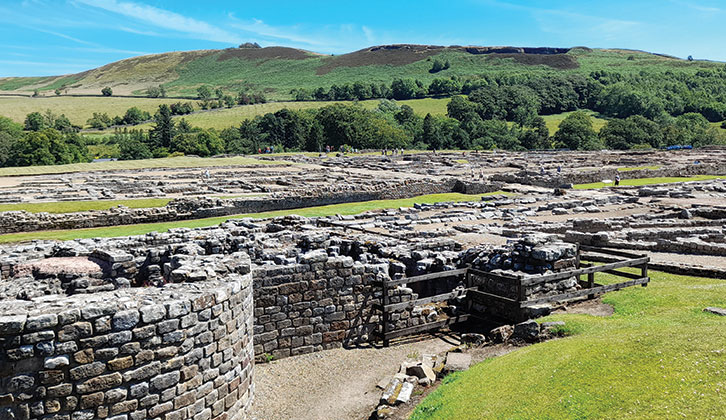
This fascinating site covers about six acres, and the free guided tour included with the admission ticket helps to interpret what you can see.
It is an active archaeological site, so discoveries continue to be made and the museum displays a selection of the finds. Some 5000 shoes, of all shapes and sizes, have been found so far.
Shoes, being so personal to an individual, offer a glimpse of the owner’s daily life and led me to wonder about the people who wore them.
Also on a very personal level, the Vindolanda tablets are perhaps the most famous finds. These thin, postcard-sized pieces of wood were used for letters and messages. Historians have gleaned all sorts of information from them, including individual names and details of the fort, such as the numbers of soldiers and their roles.
Men in the Roman army had to learn to write in Latin, so while some tablets were official messages written by scribes or officers, there are many written by ordinary soldiers and slaves.
One of the most famous is a birthday invitation from Claudia Severa, wife of a fort commander. It is thought a scribe wrote the main part, but she added a note in her own hand, a rare find as few examples of women’s writing exist from this era. (This tablet is now at The British Museum.)
The Roman Army Museum is seven miles from Vindolanda, near the village of Greenhead just off the A69. The museum examines the history of the army, with insights into the lives of the soldiers posted to Hadrian’s Wall.
It was interesting to learn how multicultural the area must have been. As the Roman forces invaded countries, they recruited soldiers along the way and these men were rarely permitted to stay in their homeland. Soldiers living and working at Hadrian’s Wall could have been from Syria, France or a multitude of other places.
Heading to Chillingham Castle
The next day we broke our journey north with a visit to Chillingham Castle. This privately owned 13th-century building is billed as ‘Britain’s Most Haunted Castle’. Although there was a distinct lack of any ghostly presence on the sunny day we visited, overnight accommodation is available if you want to experience the castle at night, and perhaps have a chance of spooky encounters!

This is altogether a very different kind of stately home. It is not a sterile museum with artefacts carefully labelled and arranged behind glass or protected by ‘do not touch’ signs everywhere.
Objects displayed are from the owner’s family collection and are not necessarily linked with the room they are displayed in, or with the castle at all. It is an eclectic collection of antiques and the owner’s family memorabilia. For example, there is a splendid painted bath, apparently designed by Louis XV’s cabinetmaker and once owned by Mick Jagger. These days, it resides in a sitting room alongside Roman fragments, fine porcelain and a 17th-century mirror.
Weapons through the ages are also on display throughout the house, along with paintings and all manner of artefacts – including a collection of fearsome instruments in the torture chamber.
Outside is a formal walled garden and a lake and woodland walk. There is also a café in the house.
Exploring Bamburgh Castle
It was now time to move onto our next motorhome site in North-East England. Our next CL was Swanfield Caravan Site, in the village of Warenford and close to the White Swan Inn. Although it is just off the A1, the location is peaceful, with fine views of the countryside.
There is a bus stop just a short walk from the campsite, so next day, we decided to catch the local bus to Bamburgh. We have visited Bamburgh village before, but never managed to get to the famous castle until now.

In the castle’s long history, it has been home to Anglo-Saxon kings, including Oswald, later venerated as a Christian saint, raided by Vikings, and used as a royal residence. During the Wars of the Roses, it was home to Henry VI, before being the first castle in England destroyed by gunfire.
In the 17th century, James I gifted Bamburgh to Claudius Forster, High Sheriff of Northumberland. The fabric of the castle has been built and rebuilt over the centuries, but the Norman keep remains the dominant feature as you approach.
You can walk around the grounds, which offer amazing views over the North Sea, while the tour inside takes you through seven staterooms.

We thought the King’s Hall, which was the original banqueting hall, was the most impressive room. It leads to rooms displayed as they would have appeared in the 19th century. The sea views from the windows are simply captivating.
Visiting Berwick-upon-Tweed
For the final day of the tour, our destination was Berwick-upon-Tweed. These days, Berwick is known as England’s most northerly town, but in the past, it was Scotland’s most southerly town. In fact, it has changed hands 13 times, in historic wars between the English and the Scots.
Berwick’s walls were constructed in the reign of Elizabeth I and contained bastions surrounded by ditches filled with water to deter invaders.
Today, they are steep, grass-covered banks providing excellent views, of both the town they used to defend and further out towards sandy beaches and the Tweed estuary.
The interesting walk around the walls is about a mile long. We came across Berwick Barracks as we strolled and called in for a quick look.
Constructed in the early 18th century, this was one of the first purpose-built barracks in England, remaining in service until 1963. Now managed by English Heritage, it houses the local museum and art gallery, and exhibitions of military history.
After walking the walls, we strolled down to the quay and looked out across the River Tweed. It was all quite peaceful, with no ships to be seen these days, although in the past, it would have been fairly bustling with vessels.
Then it was just a short walk back through the town to catch the bus to the campsite (sites with good public transport links can make a real difference to the touring experience).
As we headed home, we felt that we had only scratched the surface of what Northumberland has to offer, with plenty of the county still to be explored another time. We enjoyed learning about this great region’s history and departed knowing there was much more to discover in the future.
When to go to Northumberland
Northumberland is lovely in July. It can get rather brisk in winter, but Vindolanda and Bamburgh are open all year. Chillingham Castle is closed from October until March.
Way to go to Well House
Turn off the main A68 onto the B6342 towards Colwell. Almost immediately, take the B road on the right. Drive up the slight hill and note the woodland on the left
at the top, with the mobile phone base station. Slow as you approach the woods; the site is immediately after the woodland on the right.
Way to go to Swanfield
Head north on the A1.
About 10.8 miles north of Alnwick junction, take right turn signposted Lucker/Warenford. After 130m, at the T junction keep left. Look for the White Swan on the right and take the lane immediately to the right of the pub, before the bridge.
Where we stayed in Northumberland
Colwell, Near Hexham NE46 4HX
This site is for CAMC members only. There are several pitches, all on hardstanding. All supply fresh water, electricity and grey-water disposal. There are no showers or toilets, so you’ll need your own facilities. It is isolated – there is a bus service, but only on Tuesdays!
Greystone, North Farm, Warenford NE70 7HY
This site is also for CAMC members only. There are five pitches, all on hardstanding with fresh water and electricity. There is a drive-over grey-water disposal point. Again,
no showers or toilets. Walking distance to the bus stop.
Food and drink in Northumberland
There are numerous places to eat in Hexham and Corbridge, and small cafés at Vindolanda and the Roman Army Museum. At Swanfield, we enjoyed meals at The White Swan.
Lead image: Getty Images/iStockphoto
Head to our Best of British: Touring Adventures category to find more great travel ideas and inspiration.
If you’ve enjoyed reading this, why not get the latest news, reviews and features delivered direct to your door or inbox every month. Take advantage of our brilliant Practical Motorhome magazine SUBSCRIBERS’ OFFER and SIGN UP TO OUR NEWSLETTER for regular weekly updates on all things motorhome related





